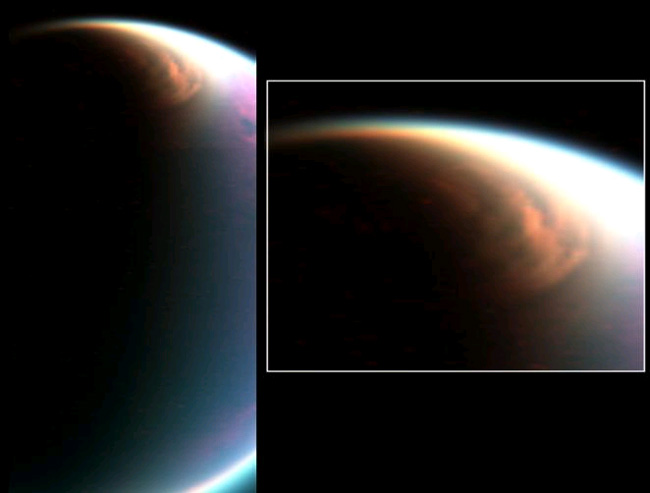On Saturn Moon Titan, Weather Report Brings Chance of Methane Rain

Scientists have used models to help predict Earth's weather for years, but now astronomers are using similar simulations to forecast rain at a more distant locale: Saturn's biggest moon Titan.
The study may help explain features such as rivers, lakes and clouds of methane on Titan, and could predict future changes, researchers said.
On Earth, water flows in a cycle, raining down from the sky, running in rivers and streams to oceans and lakes, and evaporating under sunlight into mist, forming clouds that eventually rain down. Probes sent to Titan have revealed that methane flows in a cycle there in much the same way.
To better understand the weather and climate of Titan, scientists created 3D atmospheric simulations of its methane cycle based on circulation models originally designed for Earth.
These new computer models revealed that in areas closer to Titan's equator, rare but intense storms apparently occur around the equinoxes, when days and nights on Titan are of equal length and the summer and winter poles trade places. This reversal often generates atmospheric instabilities, leading to storms capable of carving riverlike features. [Photos of Saturn's moon Titan]
"They have some similarities to the intense storms occurring in spring over the U.S. Great Plains," said study lead author Tapio Schneider, an atmospheric dynamicist at the California Institute of Technology in Pasadena.
The simulations also hint that lakes form near the poles on Titan due to accumulation of cold-trapped methane. This happens preferentially in the north, which has a longer rainy season — Saturn's oval-shaped orbit means that Saturn happens to be further from the sun when Titan is experiencing summer in the north.
Breaking space news, the latest updates on rocket launches, skywatching events and more!
In addition, the models suggest clouds form primarily in mid- and high-latitudes of the hemisphere where summer is taking place on Titan.
"The results for the first time give us a unified picture of how Titan's methane cycle works," Schneider said. "What I find most satisfying is that many seemingly disparate observations — clouds, lakes, dry river beds — can be explained within one sparse and coherent framework."
Upcoming space- and ground-based observations of Titan might confirm or reject predictions made by these models. For instance, "we predict that intense methane clouds should appear in Titan's north polar region within about two years," Schneider said. "We also predict that lake levels will rise in the northern hemisphere over the next 15 years, and we give estimates of how much methane the lakes will gain."
The scientists detailed their findings in the Jan. 5 issue of the journal Nature.
Follow SPACE.com for the latest in space science and exploration news on Twitter @Spacedotcom and on Facebook.

Charles Q. Choi is a contributing writer for Space.com and Live Science. He covers all things human origins and astronomy as well as physics, animals and general science topics. Charles has a Master of Arts degree from the University of Missouri-Columbia, School of Journalism and a Bachelor of Arts degree from the University of South Florida. Charles has visited every continent on Earth, drinking rancid yak butter tea in Lhasa, snorkeling with sea lions in the Galapagos and even climbing an iceberg in Antarctica. Visit him at http://www.sciwriter.us
